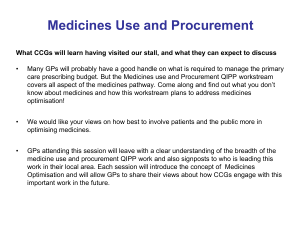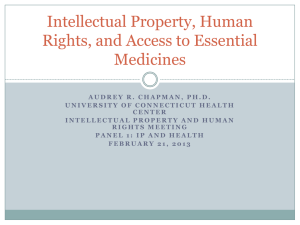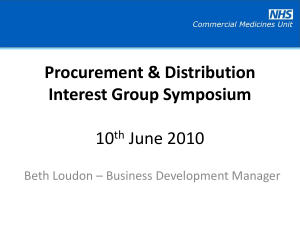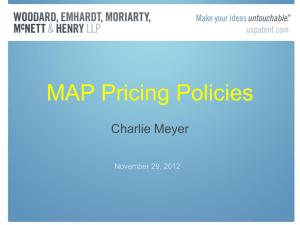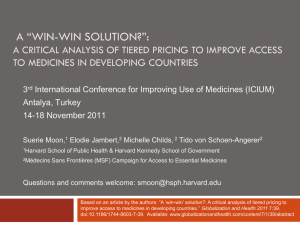Elements of Cost Plus Pricing
advertisement
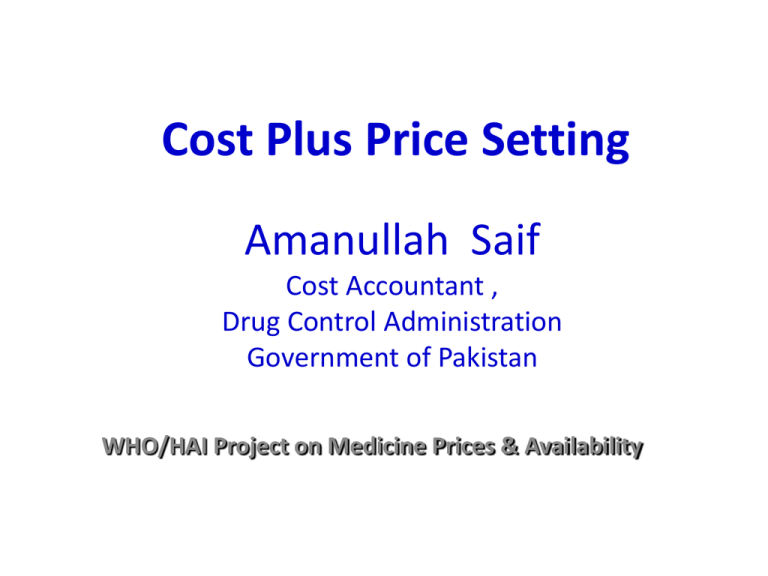
Cost Plus Price Setting Amanullah Saif Cost Accountant , Drug Control Administration Government of Pakistan WHO/HAI Project on Medicine Prices & Availability Abstract of Contribution 904 Economics, Financing, and Insurance Systems Keywords: access to medicines Cost Plus Price Setting of Medicines Problem statement: Medicine prices in the low- to middle-level income countries deprive the poor population of access to essential medicines. Objectives: To draft a policy paper describing, analyzing, and discussing cost plus price setting to assist countries which are using or intend to use the method. Design, Setting, and Study Population: To carry out global search on use of cost plus pricing method, a questionnaire was sent to 67 persons (mostly WHO/HAI survey managers) in 46 countries to identify the countries currently using or had ever used cost plus method. A web search was carried out and published and gray literatures were reviewed to find studies and literature available on use of cost plus pricing method to fix prices of medicines. It was found that 13 countries were using this method and three countries had discontinued it. It was also found that Clinton Foundation uses a template for production cost information that the manufacturer needs to fill in as part of their submission if they want to take part in the price negotiation for procurement of medicines under Clinton Health Access Initiative. A detailed questionnaire (requesting information for details on cost components, pharmaceutical market size, share of locally manufactured drugs, etc.) was sent to eight countries using the cost plus method to study how this method worked in those countries. A short questionnaire was sent to countries which had discontinued this method to study why they did so but no replies were received. Based on responses to questionnaires and published/gray literature, six case studies on countries (Bangladesh, China, India, Iran, Pakistan, and Slovakia) currently using this method were included in the paper. Evidence was found that Australia is using this method where the drug is unique in its category or when a benchmark price is being calculated for a therapeutic group. Policy : Regulation of medicines prices Results: Three billion people live in countries that use the cost plus method which makes it one of the methods worth studying though evidence on its effectiveness is limited. Its utility or effectiveness depends on the circumstances and overall health care delivery system. This method is not about patent protected medicines. It may also not be a viable option for countries with small populations or countries primarily dependent on imported medicines. Conclusions: Cost plus method is comparatively complex. Its application in conjunction with other pricing methods (such as Reference Pricing, Value Based Pricing) may provide better results. Maintenance of database on prices of raw and packing materials and other cost components will help better estimation of prices. Since regulation of medicine prices requires dynamic skills to analyze market and fair return, capacity building of the regulatory agency is critical for success of this or any other pricing method. Funding Source: WHO/Health Action International. Access to Medicines & Price Regulations • Access to essential medicines is a fundamental human right but 1/3rd of the global population lacks reliable access to needed medicines. • Individuals & families spend a very high proportion of their health budget on procurement of medicines. • Many countries regulate prices of medicines directly or indirectly. • Many price setting mechanisms are in use: one is cost plus. What is Cost Plus Price Setting “Price determination method which sets retail price by taking into account production cost of a medicine, allowance for promotional expenses, manufacturer’s profit margins and charges & profit margins in supply chain” • Definition by EU Pharmaceutical Pricing and Reimbursement Report : “Pricing Procedure which takes besides the production cost of a pharmaceutical other cost like promotional expenses and especially a profit margin for fixation of the price into account. This share is usually expressed as a percentage of the cost”. Elements of Cost Plus Pricing Materials & Prime Cost Labour + Production Overheads Production Cost + Administration Overhead & Selling and Distribution Overheads Total Cost + Profit margin for manufacturer & Any applicable taxes Ex-Factory Price + Charges & profit in supply chain & Any applicable taxes Retail Price Explanation of Cost Elements •Materials include API, excipients, packaging materials etc. •Labor includes wages/ salaries of production workers. •Production Overheads include management costs, power, depreciation of production facilities, repair & maintenance, quality assurance, etc. •Administration Overheads include salaries of administration, power and utilities, depreciation of administrative facilities, travel etc. •Selling and Distribution Overheads include salaries of marketing, depreciation on facilities used by selling and distribution departments, travel, promotional expenses etc. Study Design • Web search and PubMed search did not produce any significant literature on cost plus method . • Preliminary questionnaire sent globally to 67 persons (survey managers of Health Action International / WHO project on medicines prices) in 46 countries and 5 WHO regional offices. • 26 (39%) responded to preliminary questionnaire. • A questionnaire was sent to source persons in 13 countries to get detailed information on cost plus pricing mechanism. • A separate questionnaire was sent to 3 countries which previously used cost plus pricing mechanism to know the reasons for discontinuance of the method. • Case studies on Bangladesh, China, India, Iran, Pakistan and Slovakia were included in the study paper. Challenges in conducting the study • • • • Dearth of published literature. Difficulty in identification of source persons. Poor response to questionnaire. Lack of information to assess impact of cost plus price setting. • Cultural / organizational barriers. * • • • • • • Countries using cost plus method Australia Bangladesh China India Indonesia Iran • • • • • Lebanon Pakistan Slovakia Syria Ukraine Many of the listed countries are using cost plus in conjunction with other pricing methods and in varying degrees Cost plus method is no more in practice in Colombia, Cyprus, Greece and Spain. * List of countries using cost plus method may not be exhaustive. Clinton Foundation Procurement Clinton Foundation uses a Template for Production Cost Information that the manufacturer needs to fill in as part of their submissions if they want to take part in the price negotiation for procurement of medicines under Clinton Health Access Initiative*. This template adopts the fundamentals of cost plus pricing and may be useful for other institutional buyers and regulators for bench marking of procurement / retail prices of medicines. * http://www.clintonfoundation.org/what-we-do/clinton-health-access-initiative/information-center-resources Results • Cost Plus Method is not about patent protected medicines. • This method is not a viable option for countries with small population. • Also not a viable option for countries primarily dependent on imported medicines. • Limited evidence of its effectiveness or otherwise available. Conclusions • Cost plus method is complex as compared to reference pricing. • Capacity building of the regulatory agency is critical • Maintenance of data base on prices of raw and packing material and other cost components will help better estimation of prices under this method. • Application of this method in conjunction with other methods (such as reference pricing, value based pricing) may provide better results. • Method is worth of more studies since three billion people live in countries using cost plus.




